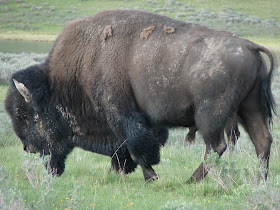By: Peggy L. Henderson
"There is perhaps no other animal that roams in this, or in the wilds of any other country,more fierce and forbidden that a buffalo ... neither the polar bear nor the bengal tiger, surpass that animal in ferocity." Alexander Ross, Fur Trapper 1825
Just last month, the bison has officially been named the National Mammal
"There is perhaps no other animal that roams in this, or in the wilds of any other country,more fierce and forbidden that a buffalo ... neither the polar bear nor the bengal tiger, surpass that animal in ferocity." Alexander Ross, Fur Trapper 1825
Just last month, the bison has officially been named the National Mammal
Bison have roamed the area known as Yellowstone as long as they roamed the Great Plains in the millions. It was a common belief that the Yellowstone bison were escapees and survivors of the mass slaughter that occurred in the 1800’s on the plains. Actually, the historic Yellowstone bison were a subspecies of that group, and lived there for thousands of years.
Fur trapper Osborne Russell, has mentioned the large numbers of bison in an area of Idaho, about 30 miles from the present park. Members of the earlier park expeditions commented that "buffalo skulls are strewn by thousands" in the Yellowstone valley about 40 miles north of the park. From these and other accounts of wild bison within what is today the park, and in adjacent areas, dating from 1860 through 1902, it is clear that a great number of bison inhabited the Yellowstone Plateau at all seasons, and long before the killing of the northern herd of Great Plains bison in the early 1880s.
 |
| Rifleman shooting bison ca 1880 NPS photo |
After Yellowstone was established as our first national park in 1872, there was no regulation in place for the killing of animals, and poachers freely killed bison. By 1902, less than thirty bison remained.
In 1886, the army took control of Yellowstone, and one of their main objectives was to regulate the killing and decimating of the natural features and wildlife. While the soldiers worked to stop illegal hunting, they were pretty much powerless to do anything other than escort the offenders outside of park boundaries, confiscate their kills, and tell them not to come back.
One brazen poacher, Ed Howell, came back time and again, and boasted of his exploits. Luckily, this backfired on him when the public finally heard about his poaching activities, and in 1894, the Lacey Act was passed by Congress, making poaching illegal and punishable.
In 1906, the Lamar Buffalo Ranch was established within Yellowstone to preserve the last free-roaming herd in the US. The bison that were brought to the ranch to mix with the last of the native mountain herd were plains bison, and as a result, today’s Yellowstone bison are a hybrid of the two. Still, they are the last genetically pure bison herd in the wild, as most other herds now have some cattle genes in them.
 |
| Lamar Buffalo Ranch 1930 NPS photo |
By the 1950’s the herd grew to over 600 animals, and ranching was stopped. The bison were set free to once again roam the park. Today, there are two distinct herds in the park – the Lamar herd, and the Mary Mountain herd. Their numbers fluctuate in any given year, but is usually somewhere around 3000 head.
Seeing bison in their natural habitat is one of the great joys when visiting Yellowstone. What many people need to remember, is that these animals are wild and dangerous.
Unfortunately, many ignore the warnings, and year after year, injuries and even deaths occur from encounters with bison.
Unfortunately, many ignore the warnings, and year after year, injuries and even deaths occur from encounters with bison.
 |
| bison calves |
The best place to see these magnificent animals is in the Hayden and Lamar Valleys. “Bison jams” are a common occurrence, since bison cross and even travel on the park road.
present day bison jam
Some fun facts about bison:
Bison are the largest mammals in North America
Bison are often called buffalo. What’s the difference? The scientific name for our North American bison is Bison bison. The buffalo is a species in Africa. The word buffalo comes from the French word beouf (beef)
Yellowstone is the only place in America where bison have continuously lived since prehistoric times
Baby bison are called “red dogs” because of their red/orange coat color
Bison may look like lumbering beasts, but they can run at speeds up to 35mph
You can judge a bison’s mood by it’s tail – if it’s raised straight up, you’d better look out! He’s gonna charge. If it’s just swishing back and forth, he’s calm and happy.
Peggy L Henderson
Western Historical and Time Travel Romance
“Where Adventure Awaits and Love is Timeless”
Award-Winning Author of:
Yellowstone Romance Series
Teton Romance Trilogy
Second Chances Time Travel Romance Series
Blemished Brides Western Historical Romance Series
Wilderness Brides Historical Romance Series
Amazon | Barnes and Noble | iTunes | Blog |Facebook |
|



Thanks for posting this, Peggy. As someone who has a home an hour away from Yellowstone and therefore gets there fairly frequently, I'm always amazed at the incredibly stupid thing people do around these animals. My daughter and I were sitting in a traffic jam when a herd came through--we found it pretty frightening so I have no idea how folks think they can take a selfie with one!
ReplyDelete